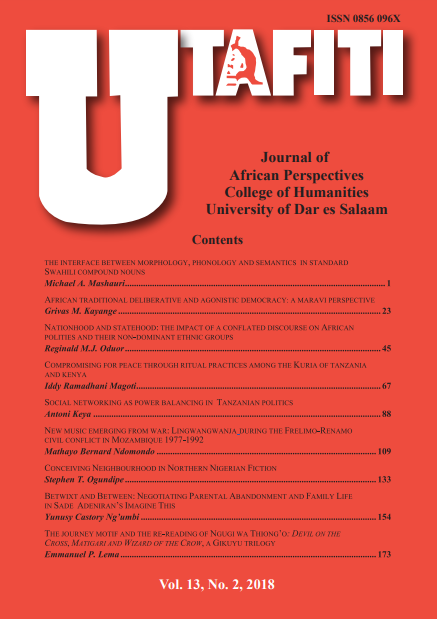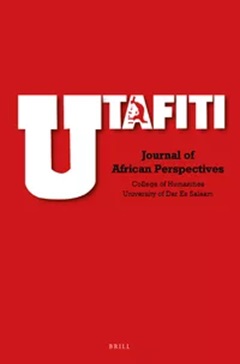The Interface Between Morphology, Phonology and Semantics in Standard Swahili Compound Nouns
Abstract
This article serves two purposes: firstly, it demonstrates the use of a constraints approach in dealing with certain aspects of Swahili. Secondly it is shown that this approach gives a clearer picture than is usually afforded of the interface of grammatical modules in forming Swahili compound nouns. Specifically this analysis will focus on the interaction between morphology, phonology and semantics in forming compounds, showing how stress, vowel length, and intonation (phonology) interact with morphology (in compounding operation) and with the meaning constraints in forming optimal compound nouns. It is argued here that optimality theory (OT) serves best in accounting for the interaction phenomena between more than two modules. Further, these considerations heuristically suggest that the constraints approach, based upon OT, might be productively employed by researchers for investigation in other fields of study across the humanities such as sociolinguistics and cultural studies involving complex communication and preservation of meaning content.
Key words: interface, noun compounds, linguistic constraints, grammar
References
Ackema, P. and Neeleman, A. 2004. Beyond Morphology: Interface
Conditions on Word Formation. New York: Oxford University
Press.
Alderete, J.A. 1999. Morphologically Governed Accent in Optimality Theory. Unpublished PhD. Dissertation, University of Massachusets, Amherst.
Ashton, E.O. 1944. Swahili Grammar. London: Longhorn.
Downing, L.J. 2013. Issues in the Phonology-Syntax Interface in African Languages. In Selected Proceedings of the 43rd Annual Conference on African Linguistics. Eds. O.O. Orie and K.W. Sanders.
Somerville, Mass: Cascadilla Proceedings Project, pp. 26-38.
Elordieta, G. 2008. An Overview of Theories of the Syntax-Phonology Interface. Anuario del Seminario de FilologÃa Vasca Julio de Urquijo [International Journal of Basque Linguistics and Philology] 42(1): 209-286.
Farmer, A.K .1985. Modular Theories of Grammar. Annual Review of Anthropology 14: 25-48.
Gichuru, T.M. 2010. Uchanganuzi wa Nomino Ambatani za Kiswahili: Mtazamo wa Mofolojia Leksika. Unpublished Masters dissertation, Kenyetta University, Nairobi.
Inkelas, S. 2011. The Interaction between Morphology and Phonology. In Handbook of Phonological Theory. Eds. J. Goldsmith, J. Riggle and A.C.L. Yu. Second edition. Oxford: Blackwell, pp. 68-102.
Ito, J. and Mester, A. 2003. Morphophonemics: Markedness and Word Structure. Cambridge, Mass: MIT Press.
Kihore, Y.M., Massamba, D.P.B. and Hokororo, J.I. 1999. Sarufi Miundo ya Kiswahili Sanifu. Dar es Salaam: TUKI.
Lechner, W. 2015. The Syntax-Semantic Interface. In Syntax, An
International Handbook. Eds. T. Kiss and A Alexiadou. Second
edition. Berlin: Mouton de Gruyter, pp. 1199-1256.
Li, Y. 2005. A Theory of the Morphology-Syntax Interface. Cambridge, MA: MIT Press
Lusekelo, A. 2014. Linguistic Morphology: A student guide. Dar es Salaam: E&D Vision Publishing.
Martinet, A. 1973 [1965]. Morphophenimcs. In Phonology. Ed. E.C. Fudge. London: Penguin Books, pp. 91-100.
Massamba, D.P.B. 2011. Maendeleo Katika Nadharia ya Fonolojia. Dar es Salaam: TUKI.
Matei, A.K. 2008. Darubini ya Sarufi: Ufafanuzi Kamili wa Sarufi. Nairobi: Phoenix.
McCarthy, J.J. and Prince, A. 1993. Generalized Alignment. In Yearbook of Morphology 1993. Eds. G. Booij and J. Van Marle. Dordrecht: Kluwer, pp. 79-153.
McCarthy, J.J. and Prince, A. 1994. The Emergence of the Unmarked: Optimality in Prosodic Morphology. In North East Linguistics Society 24. Ed. M. Gonzalez. Amherst: Graduate Linguistics Students Association, University of Massachusetts, pp. 333-379.
McCarthy, J.J. 2000. Harmonic Serialism and Parallelism. In Linguistics Department Faculty Publication series 98. Amherst: University of Massachusetts.
Mdee, J.S. 1988. Sarufi ya Kiswahili: Sekondari na Vyuo. Dar es Salaam: DUP.
Polome, E.O. 1967. Swahili Language Handbook. Washington DC: Center for Applied Linguistics.
Prince, A. and Smolensky, P. 1993. Optimality Theory: Constraint
Interaction in Generative Grammar. Report no. RuCCS TR-2. New
Brunswick, N.J: Rutgers University Center for Cognitive Science.
Selkirk, E. 2011. The Syntax-Phonology Interface. In Handbook of
Phonological Theory. Eds. J. Goldsmith, J. Riggle, and A.C.L.
Second edition. Oxford: Blackwell, pp. 435-484.
Truckenbrodt, H. 1995. Phonological Phrases. Their Relation to Syntax, Focus, and Prominence. Unpublished PhD dissertation,
Massachusetts Institute of Technology, Stanford.
Taasisi ya Uchunguzi wa Kiswahili. 1990. Kamusi Sanifu ya Isimu na Lugha. Dar es Salaam: TUKI.
Zamma, H and Kikuchi, S. 2015. Two Issues on Constraints Conjunction. Kobe City University Journal 65(5): 43-72.



